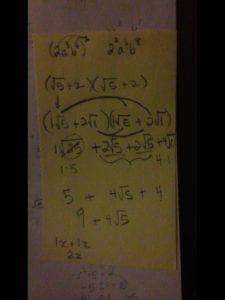This week, I had trouble creating and knowing how to make the “x” and “y” table of values from an equation, and knowing how to graph it.

If you had y = 2x^2 + 8x + 6 you would begin by finding the vertex. You would do that by factoring out 2 from the equation (because that is the value of the first number). So the equation would now become y = 2 (x^2 + 4x + 3) The next step would be to take the 4 divide it by two and then square it. Then, you would take that number (4) and create a zero pair after the 4x in the equation. The equation would now becomre y = 2 (x^2 + 4x + 4 – 4 +3). Then you put brackets around the first three numbers of the equation, y = 2 (x^2 + 4x + 4)(-4 +3). After this, you would go back to the number that you had to divide by two and then square (4), and root it, which gives you two. So the equation would now become, 2 (x + 4) (x + 4 ) (-1), which would become 2 (x + 4)^2 (-1). This would give you your vertex of (-4, -1). Once you have found your vertex, you are able to put it into the middle of the table, and move up by two, and down by two. The top number on the “y” values of your table will be the same on the top and bottom. These will give you your points for your graph. Once you have these you will be able to plot them on the graph, which you can draw based on where you points on (move the graph higher or lower). That is how you find the vertex, points, and graph an equation.







